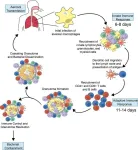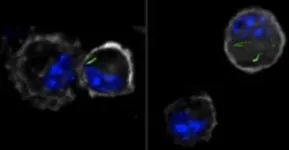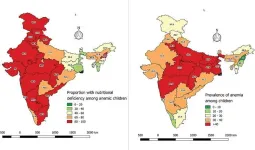(Press-News.org) AMHERST, Mass. – Tuberculosis, caused by the bacterium Mycobacterium tuberculosis (Mtb) kills upwards of 1.6 million people a year, making it one of the leading causes of death by an infectious agent worldwide—and that number is only growing larger. How, exactly, Mtb evades the immune system isn’t yet known, but a collaborative team of researchers from the University of Massachusetts Amherst and Seattle Children’s Research Institute recently discovered something surprising: prior exposure to a genus of bacteria called Mycobacterium seems to remodel the first-line defenders in the body’s immune system. Furthermore, how those cells are remodeled depends on exactly how the body is exposed. These results, published recently in PLOS Pathogens, suggest that a more integrated treatment approach that targets all aspects of the immune response could be a more effective strategy in the fight against tuberculosis.
“We breathe in thousands of liters of air every day,” says Alissa Rothchild, assistant professor in the Veterinary and Animal Sciences Department at UMass Amherst and the paper’s senior author. “This essential process makes us incredibly vulnerable to inhalation of all sorts of potentially infectious pathogens that our immune systems have to respond to.”
Systems, plural. When we think of immunity, we typically think of the adaptive immune system, which is when prior exposure to a pathogen—say, a weakened version of chickenpox—teaches the immune system what to guard against. Vaccination is the most common tool that we use to teach our adaptive immune systems what to look out for.
While the adaptive immune system is the major focus of most vaccine research (think protective antibodies induced by COVID-19 vaccines), it is not the body’s first responder—that would be the innate immune system and its ranks of macrophages. The macrophages are the first-line defenders in the tissues that recognize and destroy pathogens and also call for backup. One way they do this by turning on different inflammatory programs that can change the tissue environment.
In the case of the lungs, these macrophages are called alveolar macrophages (AMs). They live in the lung’s alveoli, the tiny air sacs where oxygen passes into the bloodstream—but, as Rothchild has shown in a previous paper, AMs don’t mount a robust immune response when they’re initially infected by Mtb. This lack of response seems to be a chink in the body’s armor that Mtb exploits to such devastating effect. “Mtb takes advantage of the immune response,” says Rothchild, “and when they infect an AM, they can replicate inside of it for a week or longer. They effectively turn the AM into a Trojan Horse in which the bacteria can hide from the body’s defenses.”
“But what if we could change this first step in the chain of infection?” Rothchild continues. “What if the AMs responded more effectively to Mtb? How could we change the body’s innate immune response? Studies over the last 10 years or so have demonstrated that the innate immune system is capable of undergoing long-term changes, but we are only beginning to understand the underlying mechanisms behind them.”
To test conditions where the innate immune response might be remodeled, Dat Mai, a research associate at Seattle Children’s Research Institute and the first author of the paper, Rothchild and their colleagues designed an experiment using two different mouse models. The first model used the BCG vaccination, one of the world’s most widely distributed vaccines and the only vaccine used for tuberculosis. In the second model, the researchers induced a contained Mtb infection, which they previously showed protects against subsequent infections in a form of concomitant immunity.
Weeks after exposure, the researchers challenged the mice with aerosolized Mtb and infected macrophages were taken from each mouse model for RNA sequencing. There were striking differences in the RNA from each set of models.
While both sets of AMs showed a stronger pro-inflammatory response to Mtb than AMs from unexposed mice, the BCG-vaccinated AMs strongly turned on one type of inflammatory program, driven by interferons, while the AMs from the contained Mtb infection turned on a qualitatively different inflammatory program. Other experiments showed that the different exposure scenarios changed the AMs themselves, and that some of these changes seem to be dependent on the greater lung environment.
“What this tells us,” says Rothchild, “is that there’s a great deal of plasticity in the macrophage response, and that there’s potential to therapeutically harness this plasticity so that we can remodel the innate immune system to fight tuberculosis.”
This research, which was supported by the National Institutes of Health and the National Institute of Allergy and Infectious Disease, is part of a much bigger, global, cross-species effort to comprehensively understand the immune responses to eliminate tuberculosis, called IMPAc-TB, for Immune Mechanisms of Protection Against Mycobacterium Tuberculosis.
Dr. Kevin Urdahl, professor of pediatrics at Seattle Children’s Research Institute, lead PI for this IMPAc-TB consortium, and one of the paper’s co-authors, says that “the overall goal of the program is to elucidate how the immune system effectively controls or eradicates the bacteria that causes tuberculosis so that effective vaccines can be developed. This is an important part of the larger IMPAc-TB program because we will be assessing the responses of human alveolar macrophages recovered from individuals who have recently been exposed to Mycobacterium tuberculosis in a TB endemic region. The findings of Rothchild’s team will help us interpret and understand the results we obtain from the human cells.”
Contacts: Alissa Rothchild, arothchild@umass.edu
Daegan Miller, drmiller@umass.edu
END
Remodeling the immune system to fight tuberculosis
Collaborative team from UMass Amherst and Seattle Children’s Research Institute uncovers how prior exposure to bacteria changes the lung’s innate immune response—and what it might mean for vaccines
2024-01-18
ELSE PRESS RELEASES FROM THIS DATE:
6 in 10 sampled under-5s in India have micronutrient deficiencies, and 4 in 10 have anaemia, per survey of 17,230 children
2024-01-18
6 in 10 sampled under-5s in India have micronutrient deficiencies, and 4 in 10 have anaemia, per survey of 17,230 children.
####
Article URL: https://journals.plos.org/globalpublichealth/article?id=10.1371/journal.pgph.0002095
Article Title: Prevalence and determinants of anemia due to micronutrient deficiencies among children aged 12–59 months in India–Evidence from Comprehensive National Nutrition Survey, 2016–18
Author Countries: India
Funding: The authors received no specific funding for this work. END ...
DNA becomes our ‘hands’ to construct advanced nanoparticle materials
2024-01-18
Evanston, IL In a paper to be published in Science Jan. 18, scientists Chad Mirkin and Sharon Glotzer and their teams at Northwestern University and University of Michigan, respectively, present findings in nanotechnology that could impact the way advanced materials are made.
The paper describes a significant leap forward in assembling polyhedral nanoparticles. The researchers introduce and demonstrate the power of a novel synthetic strategy that expands possibilities in metamaterial design. These are the unusual materials that underpin “invisibility cloaks” and ultrahigh-speed optical computing systems.
"We manipulate ...
Repeated sexual failures cause social stress in fruit flies
2024-01-18
Repeated failures to reproduce make fruit flies stressed and frustrated, which in turn makes them less resilient to other types of stress, Julia Ryvkin at Bar-Ilan University and colleagues report in the open-access journal PLOS Genetics, publishing January 18.
Animals are motivated to take actions that improve their survival and reproduction through reward systems in the brain, but failure causes stress. The reward systems have been extensively studied, but less attention has been paid to how animals respond to failure. To investigate, researchers compared ...
Complement system causes cell damage in Long Covid
2024-01-18
Most people infected with the SARS-CoV-2 virus recover after the acute illness. However, a significant proportion of infected individuals develop long-lasting symptoms with a wide range of manifestations. The causes and disease mechanisms of Long Covid are still unknown, and there are no diagnostic tests or targeted treatments.
Part of the immune system active for too long
A team of researchers led by Onur Boyman, professor of immunology at the University of Zurich (UZH) and Director of the Department of Immunology at the University Hospital Zurich (USZ), has shown in a study that the complement system plays an important role in Long Covid. It is part of the innate immune system ...
Analysis of brain tumor blood vessels yields a candidate therapy—and a platform to find more
2024-01-18
JANUARY 18, 2024, NEW YORK – A Ludwig Cancer Research study has generated a granular portrait of how the cellular and molecular components of the blood vessels that feed brain metastases of melanoma and lung and breast cancers differ from those of healthy brain tissue, illuminating how they help shape the internal environment of tumors to support cancer growth and immune evasion.
Led by Ludwig Lausanne’s Leire Bejarano and Johanna Joyce, researchers also developed a platform to identify potentially targetable vulnerabilities in the vasculature of brain metastases. They report in the current issue of Cancer ...
UChicago, Caltech study suggests that physical processes can have hidden neural network-like abilities
2024-01-18
We tend to separate the brain and the muscle—the brain does the thinking; the muscle does the doing. The brain takes in complex information about the world and makes decisions, and the muscle merely executes. This has also shaped how we think about a single cell; some molecules within cells are seen as ‘thinkers’ that take in information about the chemical environment and decide what the cell needs to do for survival; separately, other molecules are seen as the ‘muscle,’ building structures needed for survival.
But a new study shows how the molecules that build structures, i.e, the muscle, can themselves do both the thinking and the doing. The ...
Wireless drug patch shows promise as chronic disease treatment delivery system
2024-01-18
CHAPEL HILL, NC – University of North Carolina at Chapel Hill scientists created a new drug delivery system, called the Spatiotemporal On-Demand Patch (SOP), which can receive commands wirelessly from a smartphone or computer to schedule and trigger the release of drugs from individual microneedles. The patch’s thin, soft platform resembles a Band-Aid and was designed to enhance user comfort and convenience, since wearability is a crucial factor for chronically ill patients.
The research team, led by Juan Song, PhD, professor of pharmacology ...
AI can boost service for vulnerable customers
2024-01-18
AUSTIN, Texas –– Artificial intelligence has become the Swiss Army knife of the business world, a universal tool for increasing sales, optimizing efficiency, and interacting with customers. But new research from Texas McCombs explores another purpose for AI in business: to contribute to the social good.
It can do so by helping businesses better serve vulnerable consumers: anyone in the marketplace who experiences limited access to and control of resources.
“AI is widely recognized for its operational and ...
Structural study points the way to better malaria drugs
2024-01-18
Structural insights into a potent antimalarial drug candidate’s interaction with the malaria parasite Plasmodium falciparum have paved the way for drug-resistant malaria therapies, according to a new study by researchers at Weill Cornell Medicine and Van Andel Institute.
The antimalarial molecule, TDI-8304, is one of a new class of experimental therapeutics that targets the proteasome, an essential, multiprotein complex in P. falciparum cells. Two years ago, the researchers showed in a preclinical study that TDI-8304 potently kills malaria parasites at multiple stages of their life cycle and ...
VCU research promotes a business paradigm shift that emphasizes people, not just profit
2024-01-18
RICHMOND, Va. (Jan. 18, 2024) – New research from Virginia Commonwealth University fundamentally challenges the paradigm that business organizations should promote profit above all else.
Christopher S. Reina, Ph.D., executive director of the VCU Institute for Transformative Leadership, lays out the foundation for transforming business to be much more people-centered and humanistic in “Humanistic Organizing: The Transformative Force of Mindful Organizational Communication.” ...
LAST 30 PRESS RELEASES:
Tracing the quick synthesis of an industrially important catalyst
New software sheds light on cancer’s hidden genetic networks
UT Health San Antonio awarded $3 million in CPRIT grants to bolster cancer research and prevention efforts in South Texas
Third symposium spotlights global challenge of new contaminants in China’s fight against pollution
From straw to soil harmony: International team reveals how biochar supercharges carbon-smart farming
Myeloma: How AI is redrawing the map of cancer care
Manhattan E. Charurat, Ph.D., MHS invested as the Homer and Martha Gudelsky Distinguished Professor in Medicine at the University of Maryland School of Medicine
Insilico Medicine’s Pharma.AI Q4 Winter Launch Recap: Revolutionizing drug discovery with cutting-edge AI innovations, accelerating the path to pharmaceutical superintelligence
Nanoplastics have diet-dependent impacts on digestive system health
Brain neuron death occurs throughout life and increases with age, a natural human protein drug may halt neuron death in Alzheimer’s disease
SPIE and CLP announce the recipients of the 2025 Advanced Photonics Young Innovator Award
Lessons from the Caldor Fire’s Christmas Valley ‘Miracle’
Ant societies rose by trading individual protection for collective power
Research reveals how ancient viral DNA shapes early embryonic development
A molecular gatekeeper that controls protein synthesis
New ‘cloaking device’ concept to shield sensitive tech from magnetic fields
Researchers show impact of mountain building and climate change on alpine biodiversity
Study models the transition from Neanderthals to modern humans in Europe
University of Phoenix College of Doctoral Studies releases white paper on AI-driven skilling to reduce burnout and restore worker autonomy
AIs fail at the game of visual “telephone”
The levers for a sustainable food system
Potential changes in US homelessness by ending federal support for housing first programs
Vulnerability of large language models to prompt injection when providing medical advice
Researchers develop new system for high-energy-density, long-life, multi-electron transfer bromine-based flow batteries
Ending federal support for housing first programs could increase U.S. homelessness by 5% in one year, new JAMA study finds
New research uncovers molecular ‘safety switch’ shielding cancers from immune attack
Bacteria resisting viral infection can still sink carbon to ocean floor
Younger biological age may increase depression risk in older women during COVID-19
Bharat Innovates 2026 National Basecamp Showcases India’s Most Promising Deep-Tech Ventures
Here’s what determines whether your income level rises or falls
[Press-News.org] Remodeling the immune system to fight tuberculosisCollaborative team from UMass Amherst and Seattle Children’s Research Institute uncovers how prior exposure to bacteria changes the lung’s innate immune response—and what it might mean for vaccines





